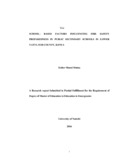| dc.description.abstract | This study investigated school-based factors influencing fire safety preparedness in public secondary schools in lower Yatta sub-county, Kenya. It was guided by the following objectives; to determine how training staff and students influences fire safety preparedness in public secondary schools, to examine the influence of disaster management committees on fire safety preparedness in public secondary schools, to establish the influence of availability of fire fighting facilities on fire safety preparedness in public secondary schools and to examine the influence of the policy on school building construction on fire safety preparedness in public secondary schools in Lower Yatta Sub-County, Kenya. The research adopted a descriptive survey design. The study targeted a population which consisted of 26 public secondary schools, 26 principals, 115 secondary school teachers and 6,320 students. This study employed simple random sampling technique to obtain the sample population The sample population consisted of all the 26 public secondary schools, 35 teachers, and 632 students. Stratified sampling technique was used to select the students that is, 316 boys and 316 girls. Data was collected by means of questionnaires administered to the principals, teachers and students of the sampled schools and an observation schedule and test re-test method was used in two schools and reliability co-efficient of principals, teachers and students questionnaire yielded 0.89, 0.86 and 0.82 respectively. Data collected from respondents was analyzed through descriptive statistics. The results were presented using frequency tables. The study findings indicated that most schools had not trained staff and students on fire disaster risk reduction, majority of schools that did not have disaster management committees and even those which had did not involve all the required stakeholders. The firefighting equipments in most schools were not enough contributing to fire safety unpreparedness. In relation to school buildings and fire safety, most schools had made some effort to improve fire disaster preparedness although majority of schools had no assembly points, windows had grills, some doors opened inwards and fire exits were obstructed. The recommendations were that all teachers, support staff and students be trained on fire disaster preparedness; schools constitute disaster management committees and that they should involve all the required stakeholders; the study also recommended that school management to consider adding the fire fighting equipments to make them adequate, also windows should not be grilled, exits should be cleared of obstructions, and doors should open outwards and that assembly points and exit routes be well labeled. Suggestions for further study were that, a study on the relationship between safety and academic performance, a comparative study on fire safety preparedness in the private and public schools in Kenya and a study to establish economic factors that influence fire safety preparedness in schools in Kenya. | en_US |



